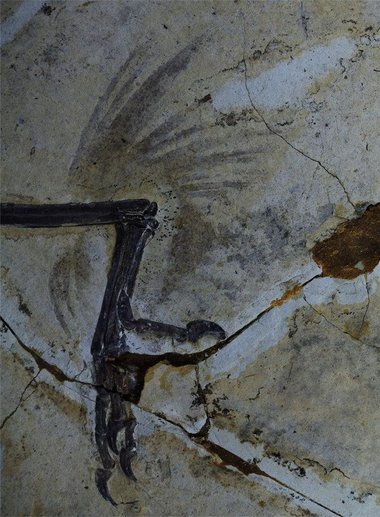By Nidhi Subbaraman, Science on BBC News | March 14, 2013

Paleontologists say the ancestor of the modern crow and turkey was a four-winged bird: In addition to the normal flappers, it had plumed legs which probably helped with aerial guidance.
Eleven samples culled from the vast fossil stores of China’s Shandong Tianyu Museum of Nature show well-preserved feathers in five different species of early birds and birdlike dinos. Plush leg feathers have previously only been spotted in fossils of flying dinosaurs, such as the four-winged Microraptor.
Xing Xu, a paleontologist at the Chinese Academy of Sciences’ Institute of Vertebrate Paleontology and Paleoanthropology, was the first to point out fossil evidence of Microraptor’s leggy plumage. He also led the team behind the latest findings, indicating that downy legs were shared by groups of early birds in the Lower Cretaceous period, 100 million to 150 million years ago. During that era, the birds were almost indistinguishable from the tiny dinos, except for differences in the tail structure and other details.
“This is what the ancestors of robins and chickens all went through,” Thomas Holtz, a paleontologist at the University of Maryland told NBC News. “It tells us that we can look at animals like Microraptor and Anchiornis and they’re still giving us information about modern birds.”
The fact that Xu and his team found evidence of leg feathers in a few different species of different sizes tells Holtz that leg plumage was fairly common. “We’re really seeing how widespread this condition was,” he says. “It’s really clarifying that it isn’t a weird side branch.”

When Microraptor and other feathered dinosaurs were spotted, their appearance strongly hinted that they were precursors to modern birds. The question at the time, Holtz explained, was: “Were we seeing something that was common, that was at the base of the family tree of birds and dinos? Or were they independent?” The new samples provide more evidence to strengthen the link.
None of the groups of early birds that Xu and team describe is new. But this is the first time feathers have been identified, partly because the fossils have been preserved so well. The group presented its work in the journal Science on Thursday.
Xu is a fossil man with a long string of feathered hits. In fact, “Dr. Xu has been involved with the naming of more dinosaurs than anyone in history!” Holtz wrote in an email to NBC News.
Following the Microraptor home run in 2003, he led a team that found Anchiornis, another plumy raptor dino in 2005, and then in 2012 revealed the gigantic Yutyrannus, a feathered relative of Tyrannosaurus rex. Dinosaurs, one after the other, but now, a bird. “So this time when I saw Sapeornis you can imagine my feelings,” Xu told NBC News. “We have a whole story — we can build a sequence to recover a pattern.”

Xu says he would describe the feathered hind-limbs as “wings” in the general sense of the term. However, he does admit that the term usually “represents a very specialized structure,” that includes muscle and bone adaptations for flight, which these new specimens don’t have. Not on their legs, anyway.
Did the leg feathers help the birds fly? They probably didn’t give the birds lift, Xu and Holtz both surmise, but they may have helped steer, something modern birds pull off with muscles and feathers on their tail.
Once the tail rudder system showed up, that could have marked the end of feathered feet. “It looks like once they evolved a far more sophisticated method of steering, they don’t need these long tail feathers any more, leaving their feet free for whatever they needed,” Holtz explains.
One of the specimens described has what looks likes webbed tissue between the toes of the bird. Xu’s theory is that that Yanornis, the crow-sized bird with these ducklike toes, may have hopped down from the trees and begun living in or around water. If walking and swimming were what the bird was using its feet for, feathers would have just gotten in the way. And so they disappeared, he explained to NBC News.
“Nonetheless, as the authors point out, future discoveries have great potential for understanding the early evolution of some groups as the Triassic Period follows a major extinction event.”
But not everyone is completely convinced that the feathers played any role in flight. “They don’t look like they have a slam dunk case,” Michael Habib of the University of Southern California told NBC News. Habib is a paleontologist who specializes in ancient flight mechanics through reconstruction. To him, the tufts on the ankles of some of the specimens don’t look too different from the feathered, downy feet of owls or eagles who use those feathers for warmth rather than flight.
Also, the way Habib sees it, Xu’s bird fossils are from the waning years of leg feathers, when they were gradually falling off. “It would not surprise me at all if a few years from now they were proven to be absolutely correct. I’m just not absolutely sure they’re correct now,” he says. But it gives him hope that other, plumier fossils are still lurking in the vast drawers of the Shandong Tianyu Museum.









